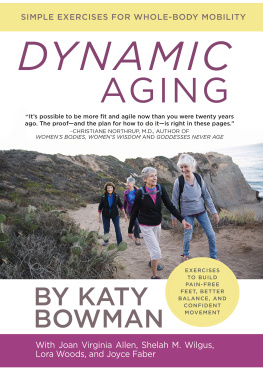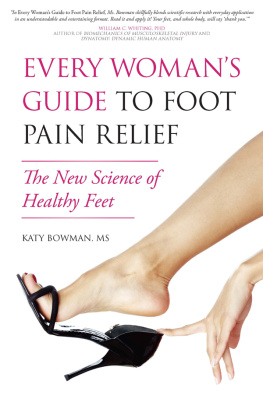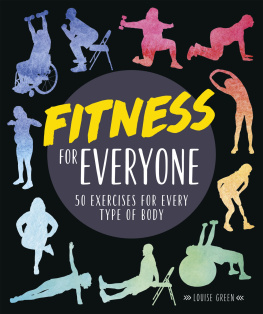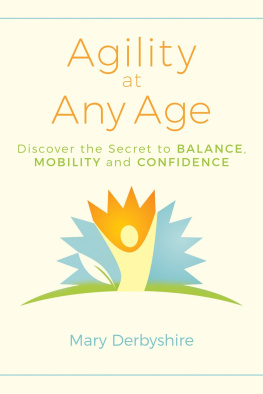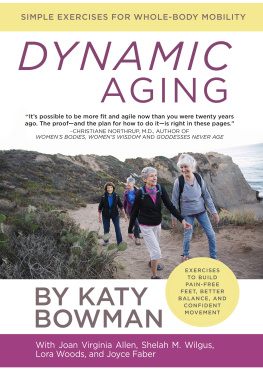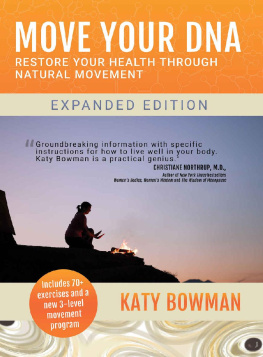Books by Katy Bowman:
Every Womans Guide to Foot Pain Relief
Alignment Matters
Move Your DNA
Dont Just Sit There
Whole Body Barefoot
Diastasis Recti
Movement Matters
Simple Steps to Foot Pain Relief
Copyright Katy Bowman 2017 with Joan Virginia Allen,
Shelah M. Wilgus, Lora Woods, and Joyce Faber
All rights reserved. No part of this publication may be reproduced, distributed, or transmitted in any form or by any means, including photocopying, recording, or other electronic or mechanical methods, without the prior written permission of the publisher, except in the case of brief quotations embodied in critical reviews and certain other noncommercial uses permitted by copyright law.
Printed in the United States of America.
First Printing, 2017
ISBN paperback: 978-1-943370-11-5
Library of Congress Control Number: 2016962297
Propriometrics Press: propriometricspress.com
Cover and Interior Design: Zsofi Koller, zsofikoller.com
Illustrations: Jillian Nichol
Front Cover Photo: John Eder Photography
Back Cover Photo: Michael Curran
Author Photos, Goldeners: Cecilia Ortiz
Author Photo, Katy Bowman: J. Jurgensen Photography
Diagram on pg. 167: Teguh Mujiono/Shutterstock
Interior Image Treatment: Shelah M. Wilgus
The information in this book should not be used for diagnosis or treatment, or as a substitute for professional medical care. Please consult with your healthcare provider prior to attempting any treatment on yourself or another individual.
Publishers Cataloging-In-Publication Data
(Prepared by The Donohue Group, Inc.)
Names: Bowman, Katy. | Allen, Joan Virginia.
Title: Dynamic aging : simple exercises for whole-body mobility / by Katy Bowman ; with Joan Virginia Allen [and 3 others].
Description: [Sequim, Washington] : Propriometrics Press, 2017. | Includes bibliographical references and index.
Identifiers: ISBN 978-1-943370-11-5 | ISBN 978-1-943370-12-2 (ebook)
Subjects: LCSH: Exercise therapy for older people. | Older people--Orientation and mobility. | Human locomotion. | Movement education. | Equilibrium (Physiology)
Classification: LCC RC953.8.E93 B69 2016 (print) | LCC RC953.8.E93 (ebook) | DDC 613.7/10846--dc23
To Katy Bowman, whose paradigm of whole-body movement is a gift that opens the door to healing the cause of pain.
J. F.
To my husband and soulmate, Willis. I love the adventure of life with you.
J. V. A.
To Shelah, Joyce, Lora, and Joan, with my love and admiration.
K. B.
To Gail Dennison, who sweetly yet consistently recommended that I try Katy Bowmans approach to joint care before resigning myself to surgery.
L. W.
To Thea, who first found Katy, and Tessa, who gets me out walking.
S. W.
TABLE OF CONTENTS
W hen I was a kid, my mother observed that I always insisted on learning the hard way, meaning that I wouldnt let myself benefit from the wisdom of others, and needed, instead, to experience lessons for myself. Fortunately, Ive grown out of this trait in many respects. Now when I meet people who have had the experience of walking down a path I am currently on, I value their insight. And what Ive learned from the people around me whove lived much longer than I have is that I need to take good care of my body, because if I dont, Ill miss being able to move how I want to.
I have had my body for only forty-one years, but over the last twenty-two, Ive had the pleasure of working one-on-one with over a thousand bodies, most of them older than mine. And if there is one message Ive received loud and clear, its that those coming to me for corrective exercise and alignment work in their sixties and seventies wish they had had access to this material in their twenties. From these people, Ive learned to value future physical function now. Thats why Ive chosen to write this book.
I teach people new ways to move their bodies. And Ive had the good fortune of working with a large group of people over a long period of time. This means I have been exposed to a lot of dataabout what people have done in the past, which hobbies and injuries they have, and where they are today.
Ive worked with groups of competitive athletes, young children, pregnant mamas, post-natal mamas, and breast cancer survivors. Ive led courses for those with cardiovascular disease, bad backs, and pelvic floor disorders, and thousands of people suffering with foot pain. Ive gathered the information on what thousands of people have done in their past, and as a result, Ive become familiar with the average movement history of todays seventy- and eighty-year-olds in my culture.
This book includes the stories of four of my clients: an attorney, a dance-movement therapist and RN, a teacher and social worker, and a sassy, kick-ass graphic artist (shes done most of the graphics in this book) who travels to far away countries. These women began working with me in their late sixties and early seventies and were part of a large group that started taking classes in my new-at-the-time exercise facility around a decade ago. They were the four who continued to show up, sometimes two hours a day Monday through Friday, for years, eventually studying to become movement teachers themselves.
Now, in their mid- to late seventies at time of writing (with one turning eighty just as this book is being published), they are some of the few of their own peer group who havent made a transition into senior living centers. They look younger now than they did years ago. They move younger than they did years ago. I regularly tell people this is possiblethat they can look, move, and feel younger through smart movement and regular trainingbut Im forty-one years old. Whos going to believe me when I say that starting at sixty or even seventy isnt too late and that tremendous improvement is possible? And so I thought I would ask Joan, Lora, Joyce, and Shelah to share with you their own insights about how a goldener can turn back the clock. Youll see their commentary throughout the book, the perspectives of four strong, dedicated, powerful women well into their seventies who are active and thriving.
But what is a goldener? When these women came to me with the idea for this book, they were clear: We dont want old in the title. Or senior. Or geriatric, for that matter. How about an all-new, beautiful term that describes how we feel about this stage of our lives, the golden age? How about goldener? I agree wholeheartedly with their thoughtful word choices, and science seems to as well.
Exercise has powerful capabilities to improve health, but so do words. During a game of charades, have you ever mimed a senior, shuffling at a snails pace, stooped over, one hand on the low back and the other on an imaginary cane? As biological beings, our behavioral patterns are shaped by what we seehow our own parents move, how our peers move. Even how cultural norms are portrayed on TV can shape our reality. The question is, how do other people move, and how do preconceived notions of the way the over sixties move affect how we move once we, ourselves, are older?
In a study created to measure the impact of positive or negative stereotype reinforcement, researchers found that walking speed and time spent in the balance phase of walking increased after only thirty minutes of intervention (Hausdorff, Levy, and Wei 1999). Did the researchers hand out a magical exercise or stretch? Nope. During a thirty-minute video game, subliminal terms were flashed on the screen:
Next page
